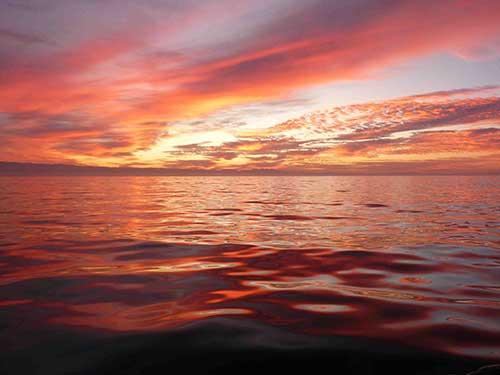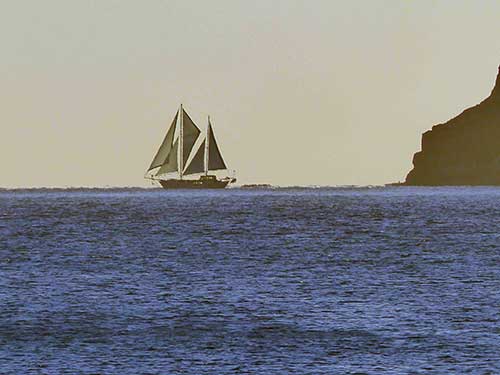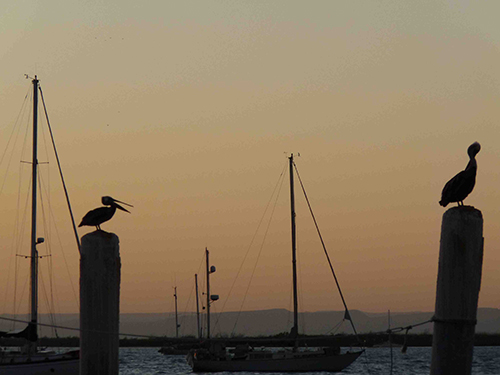
Cruising the Sea of Cortez
Section Three: Sea of Cortez Weather, Tropical Weather, Hurricanes and Hurricane Preparedness
Sea of Cortez Weather
Without the benefit of the trade winds, the wind patterns of the Sea of Cortez are dictated by the thermal effect of the heating and cooling of the peninsula, the islands, the Pacific and the Sea of Cortez itself. It is often said that “if you don’t like the wind direction, go 5 miles”.
Corumuel
The best known of these localized conditions is the Corumuel wind found in the Bay of La Paz. The main “machine” for the Corumuels is the Llano de La Paz (La Paz plain) that extends from La Paz harbor across the peninsula to south of Mag Bay. This section of desert heats up during the day causing the air to rise giving us our daily northerly component breeze. At sunset the desert cools (accelerated by much cooler Pacific) and the air falls giving us our night time southwesterly. Often the islands remain warmer than the plains causing the southwesterly to bend west and blow straight into the west facing anchorages of Espiritu Santo, Isla Partida and Isla San Francisco. For this reason, if the weather report calls for southwest or Corumuel winds, anchor accordingly. Often when the wind does this westerly bend into the anchorages it accelerates. It is not uncommon to experience 20 - 25 knot winds in the anchorage only to find it blowing 10 - 15 knots 200 yards past the entrance. This acceleration effect is especially bad in Bahia San Gabriel at the south end of Espiritu Santo. The best Corumuel protected anchorages are:
- Caleta Lobos (inner bight)
- Northeast corner of Isla Gallo
- Caleta Partida
- Playa Bonanza
- East side of Isla San Francisco
- Caleta Kevo – North side of Isla San Francisco opposite Isla Coyote
- San Evaristo – Inner bight and north side by salt ponds
For the most part normal daily conditions north of San Evaristo tend to be onshore/offshore with the strongest onshore being at the hottest time of the day and offshore during the coolest time of the night. The two big exceptions to this are Chubascos and Hurricanes.
Chubasco
The simplest way to describe a Chubasco is as a wall of wind, similar to a river holding back the tide until the tide builds up high and strong enough to spill over. They are difficult to predict, although in the last few years warnings have been put out for Chubasco conditions in a given area. They are very localized and it is not uncommon for one vessel to be awakened in the oh-dark-hours with 50 knots of wind in a lee shore while another vessel 2 miles away sleeps peacefully through the night. Warning signs to watch for and precautions to take:
- Watch for high, shiny cumulus clouds during the day and high lightning at night.
- Keep your vessel prepared with jugs, kayaks and other water toys lashed down when not in use. Roll up all tarps and awnings after sunset.
- Have a second anchor on deck and ready to go at all times. Practice dropping it.
- Record a compass bearing for your escape route.
Chubascos are of short duration – a few hours at most. More boats are lost or damaged leaving in a panic than hunkering down and riding it out.
Tropical Weather and Hurricanes

Tropical storms are generated over warm ocean waters in six parts of the world. One of these is off the west coast of Mexico from about Puerto Vallarta south to the Guatemala and El Salvador border. The area is referred to as the Eastern North Pacific Area. Baja and the Sea of Cortez are situated at the northern fringe of this tropical storm or hurricane zone. Official hurricane season runs from June 1 through November 30th with most of our more serious storms taking place between September 1 and October 30th.
A hurricane is a type of tropical cyclone, which is a generic term for a low pressure system that generally forms in the tropics. The cyclone is accompanied by thunderstorms and, in the northern hemisphere, a counterclockwise circulation of winds near the earth's surface.
Tropical cyclones are classified as follows:
Tropical Depression
An organized system of clouds and thunderstorms with a defined surface circulation and maximum sustained winds of 33 knots or less.
Tropical Storm
An organized system of strong thunderstorms with a defined surface circulation and maximum sustained winds of 34 - 63 knots.
Hurricane
An intense tropical weather system of strong thunderstorms with a well-defined surface circulation and maximum sustained winds of 64 knots or higher. Hurricanes are categorized according to the strength of their winds using the Saffir-Simpson Hurricane Scale. A Category 1 storm has the lowest wind speeds, while a Category 5 hurricane has the strongest. These are relative terms, because lower category storms can sometimes inflict greater damage than higher category storms, depending on where they strike and the particular hazards they bring. In fact, tropical storms can also produce significant damage and loss of life, mainly due to flooding.
NOAA Watch vs. Warning Forecast - Know The Difference
A Hurricane Watch
Indicates the possibility of hurricane conditions within 36 hours. This watch should trigger your disaster plan, and protective measures should be initiated, especially those actions that require extra time such as securing the boat, leaving a barrier island, etc.
A Hurricane Warning
Indicates that sustained winds of at least 74 mph are expected within 24 hours or less. Once this warning has been issued you should be in the process of completing protective actions and deciding the safest location to be during the storm. General rules and observations for our area show that the storms that track inside of the Socorro Islands are the ones that most often impact Baja and the Sea of Cortez.
Be Prepared
Unfortunately we have to put up with a hurricane threat once in a while. If you listen and participate on a regular basis to the HF nets or receive weather forecasts via HF radio or Internet, you’ll have plenty of time to get ready for an eventual blow. Some thoughts on being in the Sea of Cortez during Hurricane Season:
- Do not leave your vessel at anchor unattended (with no crew capable of running the vessel on board) during hurricane season.
- Take a slip behind a secure breakwater if possible.
- If the vessel is on a mooring dive the mooring to inspect the condition of the chain, shackles and swivels.
- If at Sea – SEEK SHELTER. The shore is not that far away from anywhere in the Sea of Cortez.
There are several options in the Sea of Cortez to find shelter such as:

- La Paz Marinas
- Puerto Escondido (Loreto area)
- Santa Rosalia Marinas
- Puerto Don Juan (Bahia de Los Angles area)
- Willard Bay (Gonzaga area)
- San Carlos
- San Felipe
- Puerto Penasco/Rocky Point
When seeking shelter in Puerto Don Juan, come in early and put a float on your anchor. This will allow boats coming in after you see where your anchor is. It is not unusual for boats to let out 250 - 300 or more feet of chain in these situations. The floats need to be removed after everybody has settled in to avoid fowled props.
To emphasize again, regardless of what location you choose to ride out a hurricane, go there early. It will give you plenty of time to get ready and will take some of the anxiety out of the event. Besides, you wouldn't want to miss the pre and post hurricane parties which normally take place wherever cruisers convene.
For more information read the articles by Carolyn Shearlock on the sailing vessel Que Tal, "Storm Anchoring" and “Riding out Marty at Anchor”, which are both good articles to read with good suggestions regarding hurricane preparedness. So is the "A Guideline for Hurricane Preparedness" by Archie on sailing vessel Sea-Tacean.
Click here to download and save Section 3 to your computer as a PDF
Section 3 contains the following files for download:
- Storm Anchoring by Carolyn Shearlock on SV Que Tal
- Riding out Marty at Anchor by Carolyn Shearlock on SV Que Tal
- A Guideline for Hurricane Preparedness by Archie on SV Sea-Tacean
"Cruising the Sea of Cortez" has been compiled by Alex and Sue on M/V Maitairoa
To keep this series updated for future cruising generations please email mvmaitairoa@gmail.com
with your suggestions, corrections, additions and deletions.